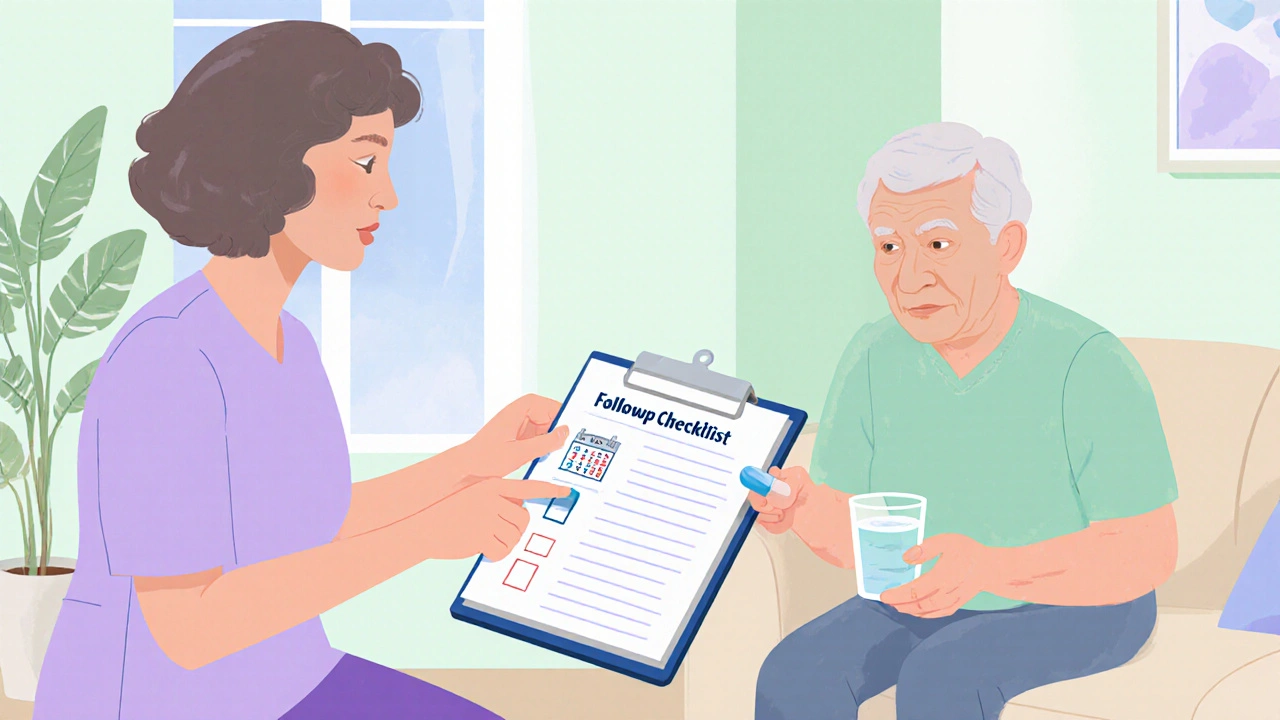Iron Deficiency Anemia Risk Assessment for Older Adults
Assess Your Risk
This tool helps you determine if you or a loved one might be at risk for iron deficiency anemia. Based on the factors described in the article, we'll calculate your risk level and provide recommendations.
Risk Assessment Result
Your risk assessment shows:
Recommendations
When a senior starts feeling unusually tired, short of breath, or notices strange bruising, the cause might be more than just ‘getting old.’ iron deficiency anemia in the elderly is a common yet often missed diagnosis that can worsen quality of life and trigger other health problems. This guide walks you through spotting the warning signs, confirming the diagnosis, and putting together a practical treatment plan that fits an older adult’s lifestyle.
Key Takeaways
- Iron deficiency anemia affects up to 15% of people over 65 and is usually linked to diet, chronic disease, or hidden bleeding.
- Typical symptoms include fatigue, dizziness, pale skin, and restless legs, but many seniors attribute them to aging.
- Diagnosis relies on a complete blood count, ferritin level, and, when needed, endoscopic investigations.
- Treatment blends iron‑rich foods, appropriate supplements, and management of the underlying cause.
- Regular monitoring every 4-6 weeks ensures recovery and prevents relapse.
Understanding Iron Deficiency Anemia in the Elderly
Iron deficiency anemia is a condition where the body lacks enough iron to produce healthy red blood cells, leading to low hemoglobin levels. In seniors, the condition often flies under the radar because symptoms overlap with other age‑related issues.
The term "elderly" generally refers to adults aged 65 and older. This age group experiences changes in gut absorption, medication use, and chronic illnesses that all increase the risk of iron depletion.

Risk Factors & Common Causes
Several factors tip the balance toward iron loss in older adults:
- Poor dietary intake: Meals that lack red meat, beans, or fortified cereals reduce iron availability.
- Gastrointestinal bleeding: Peptic ulcers, diverticulosis, or colon polyps can cause slow, chronic blood loss.
- Chronic disease: Conditions like heart failure or rheumatoid arthritis trap iron in storage cells, lowering its use.
- Medication interactions: Proton‑pump inhibitors and certain diuretics diminish stomach acidity, which is needed for iron absorption.
- Reduced absorption: Age‑related changes in the small intestine can cut iron uptake by up to 30%.
Spotting the Symptoms
Symptoms often creep in slowly, making them easy to dismiss. Look for:
- Persistent fatigue that doesn’t improve with rest.
- Shortness of breath during routine activities like climbing stairs.
- Pale complexion, especially on the inner eyelids.
- Cold hands and feet.
- Headaches or difficulty concentrating.
- Restless‑leg sensations at night.
If you notice a combination of these signs, especially after a recent change in diet or medication, it’s time to investigate further.
How Doctors Confirm the Diagnosis
Diagnosis starts with a complete blood count (CBC). Key values to watch:
- Hemoglobin below 12g/dL for women or 13g/dL for men signals anemia.
- Mean corpuscular volume (MCV) lowered (<80fL) suggests microcytic anemia, typical of iron deficiency.
- Red cell distribution width (RDW) often elevated, reflecting varied cell sizes.
Next, a ferritin test measures stored iron. Ferritin under 30ng/mL strongly points to iron shortage, although inflammation can artificially raise the number.
If lab results are ambiguous, doctors may order a iron supplement trial or use imaging (endoscopy or colonoscopy) to locate hidden bleeding sources.

Treatment Options Tailored for Seniors
Effective treatment blends three pillars: diet, supplements, and addressing the root cause.
1. Boosting Dietary Iron
Encourage iron‑rich foods that are easy to chew and digest:
- Lean red meat, chicken liver, and turkey.
- Legumes like lentils, chickpeas, and black beans.
- Fortified cereals and oatmeal.
- Dark leafy greens (spinach, kale) paired with vitaminC‑rich fruits to improve absorption.
Cooking in cast‑iron pots can add an extra 2-5mg of iron to meals.
2. Choosing the Right Iron Supplement
Not all iron pills are created equal. Below is a quick comparison of the three most common ferrous salts used for elderly patients:
| Form | Elemental Iron (mg) | Typical Dose | GI Tolerability | Best For |
|---|---|---|---|---|
| Ferrous Sulfate | 20 | 325mg PO once daily | Low-moderate | Cost‑sensitive patients |
| Ferrous Gluconate | 12 | 240mg PO twice daily | Higher | Those with sensitive stomachs |
| Ferrous Fumarate | 33 | 200mg PO once daily | Moderate | Patients needing higher elemental iron |
For most seniors, starting with ferrous gluconate reduces constipation and nausea. Take the pill on an empty stomach if tolerated; otherwise, a small amount of fruit juice (rich in vitaminC) can help.
3. Treating Underlying Causes
If chronic disease or bleeding is the culprit, iron alone won’t fix the problem. Work with a physician to:
- Adjust or replace medications that impair iron absorption.
- Schedule endoscopic procedures to stop occult GI bleeding.
- Manage inflammatory conditions with appropriate therapy.
Monitoring Progress and Preventing Relapse
After initiating treatment, follow these steps:
- Recheck CBC and ferritin after 4-6 weeks.
- Adjust supplement dose based on hemoglobin rise (aim for 1-2g/dL increase).
- Continue iron supplementation for at least 3 months beyond normalizing labs to replenish stores.
- Maintain a food diary to ensure consistent dietary iron.
- Schedule annual colonoscopy for those over 50 or with a family history of colorectal cancer.
Too much iron can be harmful, especially for seniors with heart disease, so never exceed the recommended dosage without doctor approval.

Common Pitfalls to Avoid
- Assuming fatigue is just ‘old age’ and skipping lab work.
- Choosing high‑dose supplements without checking for heart failure or liver disease.
- Ignoring vitaminC’s role in iron absorption.
- Stopping supplements as soon as energy returns.
- Overlooking medication interactions that block iron uptake.
Quick Checklist for Caregivers
- Ask the senior about new or worsening fatigue.
- Order a CBC and ferritin test.
- Review diet for iron‑rich foods and vitaminC sources.
- Discuss supplement choice with a pharmacist.
- Set a follow‑up appointment in 5 weeks.
Frequently Asked Questions
Can iron deficiency anemia cause memory problems?
Yes. Low iron reduces oxygen delivery to the brain, which can lead to difficulty concentrating, forgetfulness, and slower reaction times. Correcting the deficiency often improves cognitive clarity.
Is it safe for an elderly person to take iron supplements with heart failure?
Caution is needed. Excess iron can increase oxidative stress and worsen heart failure. A low‑dose regimen under medical supervision is recommended, and ferritin levels should be monitored closely.
Why might ferritin be normal even when iron is low?
Ferritin is an acute‑phase reactant, meaning it rises during inflammation. In older adults with chronic disease, ferritin can appear normal or high while actual iron stores are depleted.
How long does it take to feel better after starting iron therapy?
Most patients notice improved energy within 2-3 weeks, but full correction of anemia may require 2-3 months, especially if the underlying cause is still being treated.
Can diet alone fix iron deficiency in seniors?
Mild deficiencies can sometimes be corrected with iron‑rich meals combined with vitaminC. Moderate to severe cases usually need supplemental iron to refill stores quickly.

